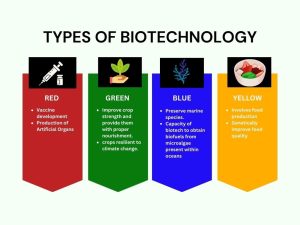In an era of scientific breakthroughs and the quest for sustainable living, Biotechnology Market innovations stand at the forefront. Biotechnology is harnessing biomolecular and cellular procedures to generate products or techniques that elevate lives. The biological processes of microorganisms have been used for many years to make useful ingredients and food products. The modern biotech realm provides cutting-edge technologies to tackle rare diseases and minimize environmental impact. From companies leveraging human genetics to possibilities of personalized medicine, biotech influence spans a profound spectrum. This technology is capable of feeding the hungry and offering them a cure. It is a cleaner, safer, and efficient technology for the future.
Delving into myriad facets of biotech transformation, it is necessary to coddle into promises this technology holds for the future. The global biotech industry was valued at USD 218,012.10 million in 2017. It is further expected to cross a valuation of USD 471,336.40 million by 2025. From healthcare to sustainable agriculture biotech applications are nothing short of overwhelming.
What are the applications of biotechnology?
- Genetic Learnings to Unfold Medical Applications
The Biotech toolbox enables genetic learning that guides drug discovery. The use of biotech has reduced the rate of infectious diseases, leading to saving many lives. The biotech process alters the life-threatening conditions that affect millions of people. Biotech continues to offer lifesaving drugs, it is expected more investors will enter into this realm. It further extends treatment to people at the top of health risks and prone to side effects. The precision and ability to detect pathogens is key advancement expected to raise the adoption of biotech in the healthcare sector.
The most recent applications of medical biotech are genetic testing and artificial tissue growth. CRISPR technology uses CRISPR-cas9 protein to cut molecules and acts like a pair of scissors for DNA. Medical biology is used here as a tool to study and edit genomes. Globally human genome projects have been supported by governments. Biotech in genetic studies is anticipated to grow in the future. It’s proven to help treat defective genes and improve them by mutation.
- Driving Food Security
Agricultural use of biotech is expected to increase and surpass the valuation of USD 25.3 billion by the end of 2025. Biotechnology is prominently used in agriculture to improve the variety of crops. It creates various genetic crops that are resilient to climate change and need no pesticides. This technology further aids in minimizing chemical runoff from farms. This technique reduces the use of pesticides farmers can get more yield from fewer resources.
Agricultural biotech is catering to advanced needs. Its ability to alter oil content in food reduces heart health risks. This technology has played a crucial role in assuring food security by creating food without any allergens. Genetically modified Organisms are creating new crops that have tolerance to abiotic stress. GMO crops have gotten a great response from farmers in Middle East countries owing to their unfavorable climate. This technology has enabled them to obtain maximum yield from minimal use of fertilizers. Biotechnology is helping countries to accomplish sustainable development goals for food security and reduce hunger and poverty.
- An Aid in Environmental Cleanup
Environmental applications of biotech assist in the creation of a healthy climate and cleaning of waste. Waste water purification and solid waste management are dominant applications of biotech. The fungi are used to synthesize enzymes that break down the harmful contaminants. It aids in the recovery of methane from landfills. Biotech has a key role in environmental cleanup and the formation of fertilizers of an organic nature to sustain agricultural outcomes.
- New Age Manufacturing, Energy, and Construction
Biotech is also used in industrial processes in the making of papers, chemicals, and biofuels. Microscopic solutions can be made using enzymes, microbes, and yeast. Bio-catalysts are used to improve the processes of manufacturing chemicals. It also lowers the cost of operations in manufacturing. Technology is helping to minimize dependence on the petrochemicals. Cleaner, efficient fuels help us to reduce our ecological footprint. It further reduces greenhouse gases, assisting manufacturers in their environmental impact. It also lowers water use and generates less wastage.
Microbes are producing biodegradable plastics. This technology has a visible association with the production of smart construction chemicals such as self-healing concrete, dust-resistant glass, and many more. In the textile sector biotech is used to produce stronger, warmer, and shrink-resistant fabrics. Finely finished garments and fabrics are highly demanded for many clothing applications. Technology has improved the uptake of dyes and enhanced the durability of fabrics.
Types of biotech

- Red Biotechnology- As per the Biotechnology Innovation Organization (BIO), biotech is assisting in the development of more than 250 vaccines. It is further useful in antibiotics, and the production of artificial organs.
- Green Biotechnology- This is used by farmers across the globe to improve their crop strength and provide them with proper nourishment. These types of processes make crops resilient to climate changes such as drought.
- Yellow Biotechnology- The realm of yellow biotech involves food production. Biotech is used for the reduction of saturated fats in oil. Biotechnology was linked to the food industry at the beginning of the 20th The main feature of this technology is it can genetically improve food quality.
- Blue Biotechnology- This refers to the use of biotech in cosmetic and marine applications. On the level of environment, this application is intended to preserve marine species. The latest research in this sector has revealed the capacity of biotech to obtain biofuels from microalgae present within oceans.
Challenges Ahead of Biotechnology Market Troupes
- Cost Battles
Both purchasers and players are suffering from cost battles. Medicine companies are debating appropriate cost sharing. Biotech manufacturing is expensive, so the R&D. FDA approval processes involve many expenses. In case of failed products, these approvals and commercialization can be daunting. This creates a challenge for private companies to gain financial investors. Only certain firms can take risk analysis and confidently invest in novel production. Without external funding, private biotech players may struggle to acquire needed equipment, skills, and outcomes. Expanding on communication with investors could remediate these financing challenges. Unified communication systems can have applications here to streamline interactions.
- Regulatory Concerns
Biotech production has to undergo approval processes before making a market appearance. Health and lifecycle landscape are regulated by FDA and federal regulations. These not only slow down the production of biotech but also create uncertainty for investors. As investors prefer faster paydays they need robust conviction to stay for longer. Aggressive quality measures are critical for public safety. Biotech players can’t cut corners of quality.
Many procedures are automated to speed up production. Analytics programs are implemented to detect any discrepancies in manufacturing. Shifting to automation has eliminated the scope for manual intervention.
Trends in Biotechnology Market
The emergence of biotech from the 1970s has catalyzed the reconfiguration of scientific promises. As a result of novel discoveries, private players are investing in this dynamically growing industry. Biotech has significant promises for the future, and they must be carefully regulated. There benefits should be maximized while reducing the risks. This section will shed light on the biotech trends beneficial for future research and humanity.
- Tissue Engineering
Biomimetic engineering has improved healthcare for the aging and diseased populace. Among several challenges, the progress in biotech, tissue engineering, and regenerative medicine has emerged as key methods for future patient needs. In the Asian Pacific region tissue engineering has received prominent attention evidenced by rising research, clinical trials, and products in this regard. Some important achievements have raised hopes for the future development of tissue engineering.
- Bioengineering
DNA sequencing is increasingly implanted in a biotech field where researchers are leveraged by information on genetics. The genome sequencing program initiated by the National Human Genome Research Institute in 1989 is among those pioneer initiatives in the direction of bioengineering. With the advent of novel sequencing methods entire genome is now decoded in days rather than months. It has opened doors of avenues for disease diagnosis and personalized medications.
- Personalized medicine
Personalized medicines are an emerging revolutionary way of future diagnosis and treatments. Molecular and genetic information is tailored for medical treatments as per the requirement of a person rather than conventional one-size-fits-all treatments. In the coming time, this field is anticipated to attract more investment and research in novel effective treatments of disease control.
- Biomanufacturing –
Naturally occurring processes that create materials and chemicals are referred to in biomanufacturing. They are normally produced in synthetic processes and the most common biomanufacturing process is fermentation. Biotech in biomanufacturing is intended to reduce energy consumption and increase productivity. Sustainability is anticipated to advancement.
- Synthetic Biology –
This trend meant to engineer novel biological systems and re-design existing ones for useful purposes. The application of synthetic DNA on silicon chips is done by Twist Bioscience. This enables the storage of DNA for next-generation sequencing. These NGS profiles are used in drug discovery. Leading biotech companies are taking an interest in the development of biotech trends are likely to bring more investment in coming years.
- Big Data in Biotech
Biotechnology Market has created a humongous amount of data. The Internet of Things (IoT) has fueled innovation in the field of biotechnology market analysis. Big data is seen as a promising technology to analyze electronic medical insights. The US government is increasing the adoption of big data analysis to study electronic medical records. The US has extended investment of USD 19 billion in this field to benefit from a pool of data and improve treatments. Genetech has used big data for its database of patients undergoing cancer treatment. This organization has analyzed electronic records to improve clinical trials and treatment.
Regional Biotechnology Market Landscape
Biotechnology Market progression is dispersed regionally due to technical advancement, growing research, and acceptance of its tremendous potential. The presence of leading biotech companies in North America marks emerging leadership in biopharmaceuticals and biotech. Extensive R&D in these regions has a profound impact on the growth of the biotechnology market realm. Biotechnology is highly integrated into healthcare, research institutes, and government initiatives. The promotion of precision medicines and progression in genomic research is attributed to bringing traction of growth in the North American Biotech Market.
US Biotechnology market is expected to expand exponentially in the coming years likely to remain a benchmark in the future. The US has seen advanced science and tech innovations that are anticipated to cross many milestones. Innovation of 3D printed organs, Bionic eyes, and bioelectric cancer detection are remarkable achievements by companies in the US. Furthermore, increased healthcare spending is contributing to the development of biotechnology.
As estimated by Deloitte, the Asia Pacific biotech industry is expected to progress with a CAGR of 10.9% in 2020-2025. It further added that expectedly APAC region will cross USD 318.8 billion valuation in biotech. The availability of funding in this sector is creating lucrative scope for private players. In 2020, the Singapore government announced USD 500 million in finance to biotech players in the country. China is also a leading investment promoter in the Asia Pacific region. Mushrooming precision medicine has enabled research in the direction of targeted therapies. Big data analysis has opened the market to new startups in this industry. Cutting-edge technologies are driving companies to desired outcomes. As the region continues to develop, it is expected to bring more innovations in the coming decade.
Future Outlook
The biotech realm holds many scientific and commercial promises for players. Early-stage scientific research has set the platform for further trials in this sector. Patents have prominent value in the biotech industry. More universities and private players are expected to obtain patents in novel applications of biotech. The rapid expansion is not only restricted to molecular biology but is also expected to expand its nature and scope further. Manufacturing of therapeutic molecules such as recombinant DNA will attract the majority of investors. Identification of clone genes related to key chronic conditions such as heart diseases and cancer will fuel the wave of biotech expansion.
Commercial genetic diagnosis is anticipated to discover novel possibilities in the promissory market of biotechnology. Drug development and clinical trials are ironically exploring biotechnology would introduce more personalized medicines and lead to cost savings. Personalized medicines are seen as better for accomplishing high returns on investments. As there is substantial support from the government is available for researchers and private players more attempts at biotech possibilities are awaited in the future.
References-
Biotechnology Innovation Organization- environmental cleanup
Genome Research Institute – Genome Research Institute
National Library of Medicines- Personalised Medicine and the Economy of Biotechnological Promise
European Pharmaceutical Manufacturer- How data science is driving genomics and pharma



